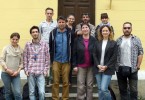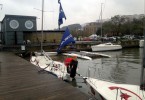Johanna Holm
Proponents claim Dolphin Assisted Therapy (DAT) can help people to ease their mental and physical problems, while the opponents argue that there is no medical proof for this claim and DAT poses serious questions and risks.
DAT, is a therapy form offered mainly to children who have mental or physical disorders. Ümit Demir, the program and activity coordinator of Istanbul Dolphinarium believes DAT is a useful method which can help children to reduce the symptoms of certain mental and physical disorders and enhance the healing process.
Dolphin assisted therapy was born in the 1970’s in the United States and because of its appeal for people suffering from a wide range of medical disorders quickly became an expanding business sector all over the world. The advocates of DAT argue that it is useful for the therapy of mental and physical problems, such as Down’s syndrome, autism, ADHD (Attention Deficity Hyperactivity Disorder), neurological disorders, depression and even AIDS or cancer.
Demir explains that in Istanbul Dolphinarium, where they offer dolphin assisted therapy for handicapped children, there has been many success stories. He especially remembers a child who had Down’s syndrome and was not able to walk or talk. After the sessions with dolphins the child could do both. However, Demir says that they never guarantee one hundred per cent healing. Dolphin assisted therapy, instead of actually healing the handicapped, may stop the disease from developing and ease the symptoms, he claims. For the critics of DAT he says, “Some people may have over exaggerated about DAT and when the miracle healing does not happen, they feel betrayed.”
In what ways dolphins can help people overcome their disabilities? Theories suggest that dolphins create ultrasonic waves that penetrate into the soft tissues and fluids of the body. Demir says these waves affect the spine and thus can cause alterations in the nerve system. He mentions the findings of a research that showed these waves emanating from dolphins can change brain wave patterns which can lead to better communication between the right and the left lobes. And its is also claimed that, especially children can benefit from DAT because of the pleasant environment in the water where they can relax and work with a professional specialist and dolphins.
However, it is not indisputably proven that dolphins can cure people. Whale and Dolphin Conservation Society, WDCS, says in its report published in 2007 that “DAT, on the contrary, can be harmful, even dangerous, for both of the participants, humans and dolphins.”
WDCS says that many of the researches made on dolphin assisted therapy are not valid or reliable. Two researchers, Lori Marino and Scott Lilienfeld from Emory University examine five such studies and in their article “Dolphin-Assisted Therapy: More Flawed Data and More Flawed Conclusions.” They conclude: “In summary, the abundance of serious threats to validity in the five studies we examined renders each of their conclusions questionable at best, and entirely unwarranted at worst.” That means that the main arguments that are used to justify the use of dolphins as therapists are shown highly arguable if not even false.
Other problem that WDCS points out is the danger DAT may cause to people and dolphins. Dolphins are not domestic animals and even in captivity they remain wild at heart. When dolphins are captured from the sea, many of them panic and die. In the dolphinariums they can get stressed because they are not allowed to live in their natural environment or carry out their natural behaviour that includes for example living in socially complex groups and hunting living fish. In practice, when under stress dolphins can become aggressive and as a consequence be dangerous to people who are in the water with them. When a human encounters a dolphin one can never know for sure what will happen and how they will react to each other; dolphins are big animals and can injure a human severely. Reported, but not well known cases of these dolphin attacks include for example broken bones, bites, tail-slaps and jaw-claps. Ümit Demir admits that if dolphins are ill-treated they can show signs of aggressiveness but also reminds that the dolphins in Istanbul Dolphinarium are born in the captivity and probably would not survive in the wild.
Another problem WDCS reports is the lack of “industry standards” or any regulating and controlling unit. In the article of Gökhan Tan in Habervesaire biologist Özgür Keşapli Didrickson from Underwater Research Association points out how little we actually know about the possible problems DAT has already caused: “How do we know about a customer whose spine is broken? Nothing is recorded. How many people were injured, how many dolphins those companies have bought and how many of them are dead?” Without common rules or supervising each company can create their own rules about how to treat both humans and dolphins.
According to its critics, dolphin assisted therapy is a business with the sole purpose of making money. Furthermore, it is clear that DAT addresses people in trouble, which may cause ethical problems. Desperate parents may be ready to pay big amounts of money trying to help their child in high hopes but end up in big disappointment. In the WDCS report a pioneering dolphin researcher Betsy Smith says “At the heart of all these therapy programs is the exploitation of vulnerable people and vulnerable dolphins.”
There seems to be some kind of consensus between the proponents and opponents that interacting with dolphins can make children feel good and help to keep their spirit up. However, there is no sufficient scientific proof or justification to use DAT. More likely, it is fun and an exciting experience which could be attainable in many other ways as well, without exploiting either animals or people.







